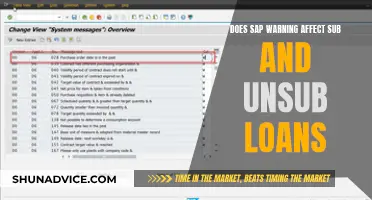
The Federal Stafford Loan, also known as the Federal Direct Loan, is a popular low-cost loan program for students to pay for their college education. Stafford loans are federal student loans made by the government and are offered as subsidized and unsubsidized loans. The loan amounts and interest rates vary depending on the student's degree level, dependency status, and financial need. There are aggregate loan limits in place to ensure students do not borrow more than the federal loan limits, and these limits are dependent on the student's specific circumstances.
| Characteristics | Values |
|---|---|
| Loan type | Federal student loan |
| Other names | Federal Direct Loan, Direct Loan |
| Administered by | U.S. Department of Education |
| Eligibility | Enrolled at least half-time, filed FAFSA, signed Master Promissory Note, meets general loan eligibility requirements (e.g., citizenship status, enrollment in an eligible program, satisfactory academic progress) |
| Credit check required | No |
| Cosigners needed | No |
| Interest rate | Varies; based on the 10-year Treasury note following the May auction plus a set margin (e.g., 4.483% + 2.05% for undergraduate Stafford loans) |
| Interest rate reduction | 0.25% if signed up for auto-debit payments online |
| Interest accrual during deferment | Yes, for Parent PLUS, Graduate PLUS, and unsubsidized Stafford Loans |
| Repayment period | 10 years (standard), longer terms available for those with over $30,000 in federal student loans |
| Loan forgiveness | Public Service Loan Forgiveness (after 10 years), Teacher Loan Forgiveness Program |
| Loan limits | Dependent on degree level, dependency status, and whether subsidized or unsubsidized; subsidized Stafford loans: up to $5,500/year, $23,000 total; unsubsidized Stafford loans: up to $7,500/year, $31,000 lifetime |
What You'll Learn

Subsidized and unsubsidized Federal Stafford Loans
Federal Stafford Loans, also known as Federal Direct Loans, are the most popular type of student loans. They are offered as subsidized and unsubsidized loans. Stafford loans are federal student loans made by the government. The name “Stafford loan” changed to “federal direct student loan” in 2010. The eligibility for a Federal Stafford Loan does not depend on the borrower’s credit scores, credit history, employment, or income. There is no credit check, and there are no cosigners on Federal Stafford Loans.
Subsidized Federal Stafford Loans are offered to undergraduate students who demonstrate financial need as determined through the Free Application for Federal Student Aid (FAFSA). The federal government is responsible for paying the interest while the student is in school or during periods of deferment. The student is then responsible for the interest that begins to accrue after the six-month grace period and throughout the repayment period.
Unsubsidized Federal Stafford Loans are offered to undergraduate and graduate students regardless of financial need. No credit check is required. Interest is charged throughout the loan, and monthly payments are not required until six months after the student leaves school.
The interest rates for both subsidized and unsubsidized undergraduate Federal Stafford Loans are the same. These rates reset for new loans on July 1 each year. For loans first disbursed on or after July 1, 2024, and before July 1, 2025, the rate is 6.53%. Graduate or professional students receive an 8.08% interest rate. These are fixed interest rates that won't change for the life of the loan.
Weekend Loan Approvals: Sofi's Lending Availability
You may want to see also

Aggregate loan limits
The aggregate loan limit for a student is determined by their degree level, dependency status, and whether the loans are subsidised or unsubsidised. The aggregate loan limit includes any outstanding Direct Subsidised Loan and Direct Unsubsidised Loan amounts, as well as any outstanding Subsidised and Unsubsidised Federal Stafford Loans previously borrowed under the FFEL (Federal Family Education Loan) Program.
For instance, a dependent undergraduate may have up to a maximum of $31,000 in combined subsidised and unsubsidised outstanding loan debt, but no more than $23,000 of this amount may consist of subsidised loans. Dependent students have lower combined subsidised/unsubsidised annual loan limits than independent students. However, if a dependent student's parent(s) cannot borrow a Direct PLUS Loan, the student becomes eligible for the higher combined subsidised/unsubsidised annual loan limits that are otherwise available only to independent students.
For undergraduate students, the loan limit must be prorated if the student is enrolled in a program that is less than an academic year. The annual loan limit is the maximum loan amount that a student may receive for one academic year. The student's maximum annual loan limit increases as they progress to higher grade levels.
To ensure that a student doesn't exceed the aggregate loan limits, their FAFSA data is matched with NSLDS (National Student Loan Data System), and if they have exceeded or are approaching the aggregate loan limits, this will be noted in the ISIR (Institutional Student Information Record).
SS Calamity Loan: What You Need to Know
You may want to see also

Eligibility requirements
The Federal Stafford Loan, also known as the Federal Direct Loan, is the largest and most popular student loan program. Stafford loans are federal student loans made by the government and offered as subsidized and unsubsidized loans. The eligibility requirements for a Federal Stafford Loan are as follows:
Enrollment Status
To be eligible for a Federal Stafford Loan, a student must be enrolled at least half-time.
Financial Need
Eligibility for a subsidized Federal Stafford Loan is based on financial need, which is shown when the applicant files the FAFSA (Free Application for Federal Student Aid). These loans have lower borrowing limits than their unsubsidized counterparts. In contrast, eligibility for an unsubsidized Federal Stafford Loan does not depend on financial need, and even wealthy students can qualify for unsubsidized loans.
Citizenship Status
The applicant must satisfy general loan eligibility requirements for federal student aid, including citizenship status.
Academic Progress
The applicant must be maintaining satisfactory academic progress.
Previous Federal Student Loan Debt
The applicant must not be in default on a federal student loan or grant overpayment.
Degree Level and Dependency Status
The aggregate loan limits depend on degree level, dependency status, and whether the loans are subsidized or unsubsidized. For example, dependent students have lower combined subsidized/unsubsidized annual loan limits than independent students. However, if a dependent student's parents cannot borrow a Direct PLUS Loan, the student becomes eligible for the higher loan limits of an independent student.
Enrollment in an Eligible Program
The applicant must be enrolled in an eligible degree or certificate program.
Speedy Title Loans: What You Need to Know
You may want to see also

Interest rates
The interest rates for Stafford Loans are fixed for the life of the loan. Undergraduate Stafford Loans have an interest rate of 6.53%, while graduate Stafford Loans have an interest rate of 8.08%.
The interest rates for Stafford Loans are also different for subsidized and unsubsidized loans. Subsidized Stafford Loans are based on financial need, while unsubsidized Stafford Loans are not. Unsubsidized Stafford Loans have higher borrowing limits than subsidized loans.
Borrowers may receive a 0.25% interest rate reduction if they sign up for auto-debit payments online. The standard repayment period for Stafford Loans is 10 years, but longer repayment terms are available for those with higher loan amounts.
St. Catherine's Self-Loan Acceptance: What You Need to Know
You may want to see also

Repayment options
For borrowers who are unable to keep up with their monthly payments, there are a number of popular repayment plans available, including income-based repayment. In this plan, monthly loan payments are based on a percentage of the borrower's income, with the remaining debt forgiven after a certain number of years. The payment is based on 15% of discretionary income, defined as the amount by which adjusted gross income (AGI) exceeds 150% of the poverty line.
Additionally, there are loan forgiveness programs available for those in certain professions. Public Service Loan Forgiveness is available after 10 years of qualifying payments and employment for Direct Loans (excluding Parent PLUS). The Teacher Loan Forgiveness Program is available for Stafford Loans in both the Direct and FFEL programs. Teachers with Perkins loans may also be eligible for loan cancellation if they meet certain requirements.
It is important to note that the Federal Stafford Loan has fixed rates, and interest rates are set each year for new loans. While borrowers are not required to make monthly payments until six months after leaving school, interest is charged throughout the life of the loan. For Parent PLUS, Graduate PLUS, and unsubsidized Stafford Loans, interest continues to accrue even during periods of deferment.
Borrowing Clothes: Water Waste and Small Loans
You may want to see also
Frequently asked questions
Stafford Loans, also known as Federal Direct Loans, are low-cost loans borrowed by students to pay for their college education. They are the most popular type of student loan. Stafford Loans are available as subsidized and unsubsidized loans.
The borrowing limits for Stafford Loans depend on the degree level, dependency status, and whether the loans are subsidized or unsubsidized. For subsidized Stafford Loans, students can borrow up to $5,500 a year, or $23,000 total. For unsubsidized Stafford Loans, students can borrow up to $7,500 a year, or up to $31,000 in their lifetime. Graduate students have higher borrowing limits, with up to $20,500 annually for grad school and up to $40,500 annually for medical school.
Eligibility for Stafford Loans is based on financial need for subsidized loans, while unsubsidized loans do not require a demonstration of financial need. To be eligible for a Federal Stafford Loan, the student must be enrolled at least half-time, file the Free Application for Federal Student Aid (FAFSA), and sign a Master Promissory Note (MPN). Other general loan eligibility requirements include citizenship status, enrollment in an eligible degree or certificate program, and satisfactory academic progress.
The standard repayment period for Stafford Loans is 10 years, but longer repayment terms are available for larger loan amounts. Monthly loan payments are based on a percentage of the borrower's income, and remaining debt can be forgiven after a specific number of years. Payments are typically due after the borrower graduates, leaves school, or changes their enrollment status to less than part-time.







